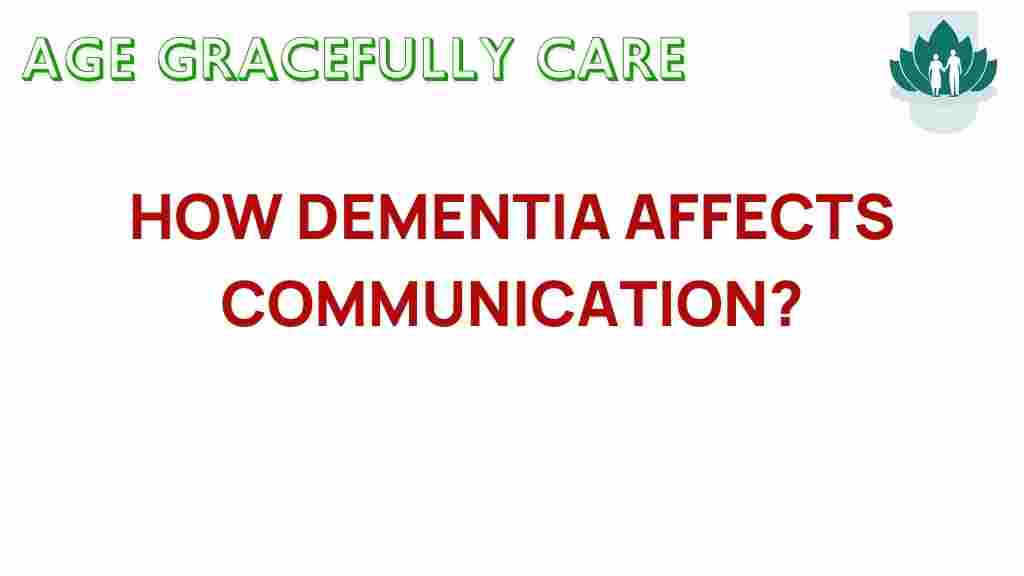Unraveling the Silent Struggle: How Dementia Impacts Communication
Dementia is a condition that profoundly affects not just memory but also the ability to communicate. As cognitive decline progresses, individuals with dementia face numerous challenges in their ability to express thoughts, understand language, and engage in meaningful conversations. This article will explore the intricate relationship between dementia and communication, shedding light on how these challenges affect patient care, social interaction, and emotional connections.
The Nature of Dementia and Cognitive Decline
Dementia is an umbrella term for a range of conditions characterized by a decline in cognitive function, impacting memory, thinking, and social abilities. As dementia progresses, language skills can deteriorate, leading to significant communication difficulties. Understanding these changes is crucial for caregivers and healthcare professionals.
- Types of Dementia: Alzheimer’s disease, vascular dementia, Lewy body dementia, and frontotemporal dementia.
- Stages of Dementia: Early, middle, and late stages each present unique challenges regarding communication.
The Impact of Communication Barriers
Effective communication is vital for maintaining emotional connections and ensuring quality patient care. However, dementia creates significant language barriers that can lead to frustration for both patients and caregivers.
- Word Finding Difficulties: Individuals may struggle to recall words, leading to pauses or incomplete thoughts.
- Loss of Context: Patients may lose track of conversations or struggle to understand the context of discussions.
- Nonverbal Communication: Body language and facial expressions may also become challenging to interpret.
Understanding the Communication Changes in Dementia
Understanding the specific communication changes that occur with dementia can provide insight into effective strategies for interaction. Here are some common changes individuals with dementia may experience:
- Receptive Language Deficits: Difficulty understanding spoken or written language.
- Expressive Language Deficits: Challenges in articulating thoughts or forming coherent sentences.
- Reduced Vocabulary: A shrinking vocabulary may limit the ability to express complex ideas.
- Increased Use of Nonverbal Communication: Gestures, facial expressions, and tone of voice become more significant.
Step-by-Step Process for Enhancing Communication
Improving communication with individuals experiencing cognitive decline involves patience, understanding, and the use of specific strategies. Here’s a step-by-step process to enhance communication:
Step 1: Assess the Individual’s Communication Style
Each person with dementia may have unique communication preferences. Take time to observe their style, including:
- Preferred topics of conversation.
- Responses to different types of questions.
- Use of gestures or nonverbal cues.
Step 2: Create a Supportive Environment
Minimize distractions to enhance focus during conversations. Consider the following:
- Choose a quiet space for discussions.
- Maintain eye contact to foster connection.
- Use clear, simple language and avoid jargon.
Step 3: Use Active Listening Techniques
Active listening involves fully engaging with the speaker. This can be accomplished by:
- Paraphrasing what the individual says.
- Encouraging them to elaborate on their thoughts.
- Responding with empathy and understanding.
Step 4: Incorporate Nonverbal Communication
Nonverbal cues can enhance understanding and emotional connection. Consider the following:
- Use positive body language, such as nodding and smiling.
- Be aware of the individual’s nonverbal cues.
- Utilize touch appropriately to convey support.
Step 5: Be Patient and Flexible
Patience is key when communicating with individuals experiencing dementia. Adapt your approach based on their responses and be prepared to repeat or rephrase information as needed.
Troubleshooting Communication Challenges
Despite best efforts, communication challenges may persist. Here are some troubleshooting tips to address common issues:
Problem: The Individual Seems Confused
Solution: Simplify your language, speak slowly, and ask one question at a time. Allow for pauses for the individual to process information.
Problem: Frustration During Conversations
Solution: Validate their feelings. If they express frustration, acknowledge it and redirect the conversation to a more comfortable topic.
Problem: Withdrawal from Social Interaction
Solution: Encourage involvement in activities that they enjoy. Use familiar topics to spark interest and engagement.
Building Emotional Connections Despite Language Barriers
The emotional bond between caregivers and individuals with dementia can remain strong, even when verbal communication is challenging. Here’s how to foster emotional connections:
- Share Memories: Discuss past events, photos, or music that may trigger positive memories.
- Use Humor: Laughter can ease tension and create a joyful atmosphere.
- Engage in Activities Together: Participate in activities such as gardening, arts and crafts, or listening to music to strengthen the bond.
Healthcare Professionals and Communication Strategies
Healthcare professionals play a crucial role in providing patient-centered care for individuals with dementia. Effective communication strategies can enhance patient outcomes:
- Training in Dementia Care: Healthcare workers should receive training on the unique communication needs of dementia patients.
- Involving Family Members: Include family members in care discussions to ensure comprehensive understanding and support.
- Utilizing Technology: Explore assistive technologies that may aid communication, such as speech-generating devices.
The Importance of Understanding in Patient Care
Understanding the impact of dementia on communication is essential for effective patient care. Caregivers and healthcare providers must:
- Recognize the signs of cognitive decline and adjust communication accordingly.
- Promote an environment that encourages social interaction and emotional connection.
- Stay informed about the latest research and techniques in dementia care.
For more information on patient-centered approaches to dementia care, visit Alzheimer’s Association.
Conclusion
In conclusion, dementia significantly impacts communication, presenting challenges that affect emotional connections and social interactions. By understanding these challenges and employing effective communication strategies, caregivers and healthcare professionals can foster better relationships with individuals experiencing cognitive decline. Emphasizing patience, empathy, and the use of nonverbal cues can bridge the language barriers that dementia creates, leading to improved patient care and a deeper emotional connection. Remember, every effort made in enhancing communication can transform the silent struggle of dementia into a shared experience of understanding and compassion.
For further reading about improving communication with dementia patients, check out this resource.
This article is in the category Health and created by AgeGracefullyCare Team
